Hello everyone, Good news! The EC14012 paper is now available on astro-ph. Here is the link: http://arxiv.org/pdf/1204.2558.pdf. The paper will be coming out in the June edition of ApJ. DAMP05 has started. We've been observing GD165 to evaluate the star for convective light curve fitting. This is a hot DA, and would help pin down the hot end of our convection plot (Figure 17 in the EC14012 paper) where we only have G117-B15A right now. The star still has 2 major frequencies, at 120 and 193 s. Both are mulitplets. The 120 s multiplet seems very similar to the previous published frequencies, but the 193 s multiplet is not yet resolved! Of course, we need more data! Check out the website to see the latest light curves and FTs. Cheers, Judi
Judi Provencal
- Judi Provencal
- B.A., Smith College, 1987 M.A., Astronomy, The University of Texas, 1990 Ph.D., Astronomy, The University of Texas, 1994 2005-present: Director, Delaware Asteroseismic Research Center 2005-present: Director, Whole Earth Telescope 2000-present: Resident Astronomer, Mt. Cuba Observatory and the University of Delaware
Saturday, April 21, 2012
EC14012 Paper and DAMP05 Update
Tuesday, April 10, 2012
News from the Director
Hello everyone, The website is up for DAMP05 at http://darc.physics.udel.edu/wet/damp05/phptools/index.php. We are still confirming a few sites, but it looks like things will start next week and run until the beginning of May. This is going to be a small run to evaluate GD165 and its potential for light curve fitting. The secondary target is GD358 because it is fairly bright and doesn't need lots of coverage. Unless of course, it changes this year:) The finder charts and observing instructions are available on the website. The information for uploading data to daedalus is the same as in the past. If anyone needs a reminder, let me know. Two other bits of news: Happily, the EC14012-1446 paper has been accepted for publication in the Astrophysical Journal (tentatively for the June 10 edition). It should appear on astro-ph in a few days. This is very exciting. The paper presents the FT and light curve fitting for EC14012-1446, and raises some other interesting questions. I hope everyone will take a look. Planning for the 8th Whole Earth Telescope Workshop is proceeding. We have been discussing a format which is more in line with the "traditional" workshop. We would spend a good deal of the meeting focusing on a single star, with the idea of leaving with the framework for a publication. The suggested "focus" star is G29-38, since it has a comprehensive, extensive data set of photometry and spectroscopy and it impacts a broad range of fields, from pulsation to disks. This part of the workshop would be open discussion, focusing on the entire data set to address questions of interest. I think this sounds very exciting. Please let me know if you have any suggestions. Cheers, Judi
Friday, April 6, 2012
Delaware Military Academy
On March 27 I went to the Delaware Military Academy to talk to the
seniors and juniors about possible careers in astronomy. I talked
to four separate classes. They were all very interested and asked
lots of questions. I need to brush up on my black hole theory!
Also had lots of questions about Jupiter and Venus, which are very
easy to see after sunset.
seniors and juniors about possible careers in astronomy. I talked
to four separate classes. They were all very interested and asked
lots of questions. I need to brush up on my black hole theory!
Also had lots of questions about Jupiter and Venus, which are very
easy to see after sunset.
Wednesday, April 4, 2012
New Supernova
I heard about a new supernova that appeared in M95 around
March 16. It was a Type II supernova, which
is a massive star that has exploded. This galaxy is 37 million light
years away. It was sort of clear tonight for my observational
astronomy class from the University, so we used the 24 inch telescope
to capture this image of M95.
The arrow points to the supernova. It was sort of hazy, and M95 was
right above Wilmington, so the sky is kind of
rough. The other picture is an older image I found of M95 before the supernova.
March 16. It was a Type II supernova, which
is a massive star that has exploded. This galaxy is 37 million light
years away. It was sort of clear tonight for my observational
astronomy class from the University, so we used the 24 inch telescope
to capture this image of M95.
The arrow points to the supernova. It was sort of hazy, and M95 was
right above Wilmington, so the sky is kind of
rough. The other picture is an older image I found of M95 before the supernova.
Thursday, March 29, 2012
Future Astronomers
March 13 - James and I went to West Park Place school to do a star
party for the 4th grade classes. James borrowed 4 portable Celestron
telescopes from the University. The night was pretty clear and
quite warm. Jupiter, Venus and Mars were all easy to find. There
were about 30 kids (plus quite a few parents:) there. They all
had a great time looking through the telescopes. Everyone loved
Jupiter with its moons, and you could see the polar cap on Mars.
party for the 4th grade classes. James borrowed 4 portable Celestron
telescopes from the University. The night was pretty clear and
quite warm. Jupiter, Venus and Mars were all easy to find. There
were about 30 kids (plus quite a few parents:) there. They all
had a great time looking through the telescopes. Everyone loved
Jupiter with its moons, and you could see the polar cap on Mars.
Thursday, March 15, 2012
Subscribe to:
Posts (Atom)



